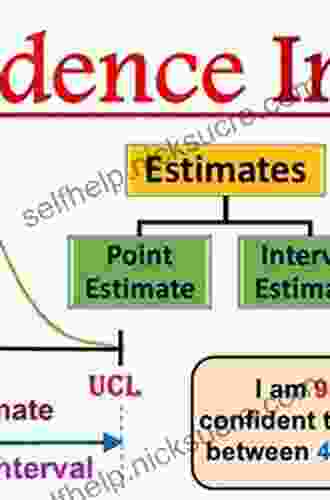Statistics With Confidence: Confidence Intervals and Statistical Guidelines

Statistics are a powerful tool that can be used to make informed decisions in a variety of settings. However, it is important to understand the limitations of statistics and to be aware of the potential for error when interpreting statistical results.
One of the most important concepts in statistics is the confidence interval. A confidence interval is a range of values that is likely to contain the true value of a population parameter. For example, if we are interested in estimating the average height of women in the United States, we could conduct a survey of 100 randomly selected women and calculate the average height of those women.
4.5 out of 5
| Language | : | English |
| File size | : | 6209 KB |
| Text-to-Speech | : | Enabled |
| Screen Reader | : | Supported |
| Enhanced typesetting | : | Enabled |
| Print length | : | 321 pages |
| Lending | : | Enabled |
The average height of the women in our sample is an estimate of the true average height of women in the United States. However, we cannot be certain that our estimate is exactly correct. There is a chance that the true average height is slightly higher or lower than our estimate.
The confidence interval gives us a range of values that is likely to contain the true average height. For example, we might calculate a 95% confidence interval of 64 inches to 68 inches. This means that we are 95% confident that the true average height of women in the United States is between 64 inches and 68 inches.
Confidence intervals are a valuable tool for interpreting statistical results. They help us to understand the precision of our estimates and the potential for error.
Types of Confidence Intervals
There are two main types of confidence intervals:
- One-sample confidence intervals
- Two-sample confidence intervals
One-sample confidence intervals are used to estimate a population parameter from a single sample. For example, we could use a one-sample confidence interval to estimate the average height of women in the United States from a survey of 100 randomly selected women.
Two-sample confidence intervals are used to compare two population parameters from two different samples. For example, we could use a two-sample confidence interval to compare the average height of women in the United States to the average height of women in Canada from two surveys of 100 randomly selected women from each country.
How to Calculate Confidence Intervals
The formula for calculating a confidence interval depends on the type of confidence interval and the sample size. For one-sample confidence intervals, the formula is:
CI = x̄ ± Z * (s / √n)
where:
* CI is the confidence interval * x̄ is the sample mean * Z is the z-score associated with the desired confidence level * s is the sample standard deviation * n is the sample size
For two-sample confidence intervals, the formula is:
CI = (x̄1 - x̄2) ± Z * √((s1^2 / n1) + (s2^2 / n2))
where:
* CI is the confidence interval * x̄1 is the sample mean of the first sample * x̄2 is the sample mean of the second sample * Z is the z-score associated with the desired confidence level * s1 is the sample standard deviation of the first sample * s2 is the sample standard deviation of the second sample * n1 is the sample size of the first sample * n2 is the sample size of the second sample
Statistical Guidelines
There are a few general guidelines that should be followed when using statistics:
* Use random samples. Random samples are the only way to ensure that your results are representative of the population you are interested in. * Use appropriate statistical tests. There are a variety of statistical tests that can be used to test different hypotheses. It is important to use the appropriate test for the type of data you have and the hypothesis you are testing. * Interpret statistical results carefully. When interpreting statistical results, it is important to consider the following factors: * The sample size * The confidence level * The p-value * The effect size
Statistics are a powerful tool that can be used to make informed decisions. However, it is important to understand the limitations of statistics and to be aware of the potential for error when interpreting statistical results. By following the guidelines above, you can ensure that you are using statistics correctly and that you are interpreting the results accurately.
4.5 out of 5
| Language | : | English |
| File size | : | 6209 KB |
| Text-to-Speech | : | Enabled |
| Screen Reader | : | Supported |
| Enhanced typesetting | : | Enabled |
| Print length | : | 321 pages |
| Lending | : | Enabled |
Do you want to contribute by writing guest posts on this blog?
Please contact us and send us a resume of previous articles that you have written.
 Fiction
Fiction Non Fiction
Non Fiction Romance
Romance Mystery
Mystery Thriller
Thriller SciFi
SciFi Fantasy
Fantasy Horror
Horror Biography
Biography Selfhelp
Selfhelp Business
Business History
History Classics
Classics Poetry
Poetry Childrens
Childrens Young Adult
Young Adult Educational
Educational Cooking
Cooking Travel
Travel Lifestyle
Lifestyle Spirituality
Spirituality Health
Health Fitness
Fitness Technology
Technology Science
Science Arts
Arts Crafts
Crafts DIY
DIY Gardening
Gardening Petcare
Petcare James Nestor
James Nestor Seth Kantner
Seth Kantner Tracy Deonn
Tracy Deonn Lori Foster
Lori Foster Temple Bailey
Temple Bailey Foster Provost
Foster Provost Lyn Millner
Lyn Millner David Dalglish
David Dalglish Steven Brill
Steven Brill Leonard Susskind
Leonard Susskind Matt Wallaert
Matt Wallaert Avery Faigenbaum
Avery Faigenbaum Gillian Bradshaw
Gillian Bradshaw Larry Olmsted
Larry Olmsted Jeffrey Freed
Jeffrey Freed Samir Okasha
Samir Okasha Johny Pitts
Johny Pitts Rachel Mitchell
Rachel Mitchell Graham Frankel
Graham Frankel Chris Santella
Chris Santella Robert W Sullivan Iv
Robert W Sullivan Iv James Garbarino
James Garbarino Reinhard Bonnke
Reinhard Bonnke Moon Travel Guides
Moon Travel Guides Quick Reads
Quick Reads Daffodil Campbell
Daffodil Campbell Shelley Johnson
Shelley Johnson Linda Wong
Linda Wong Ben Riggs
Ben Riggs Fran Zimniuch
Fran Zimniuch Judith Z Kallenbach
Judith Z Kallenbach Gary Webster
Gary Webster N West Moss
N West Moss Luca Caioli
Luca Caioli Peggy Kaye
Peggy Kaye Katie Cotugno
Katie Cotugno Dk
Dk Suzanne Jurmain
Suzanne Jurmain George Orwell
George Orwell Lore M Dickey
Lore M Dickey Dk Eyewitness
Dk Eyewitness Beverly Bell
Beverly Bell Inga Aksamit
Inga Aksamit Sarah B Bush
Sarah B Bush Robert Warden
Robert Warden Patty Hahne
Patty Hahne Tony Clunn
Tony Clunn Lara Lillibridge
Lara Lillibridge Steven Rinella
Steven Rinella Timothy J Jorgensen
Timothy J Jorgensen Fennel Hudson
Fennel Hudson Dima Zales
Dima Zales Jeff Szuhay
Jeff Szuhay Sofia Price
Sofia Price M Prefontaine
M Prefontaine William Woys Weaver
William Woys Weaver Patricia L Thompson
Patricia L Thompson Dave Ramsey
Dave Ramsey Maureen Connolly
Maureen Connolly Tracey L Moore
Tracey L Moore Ayesha Ratnayake
Ayesha Ratnayake Jessica S Olson
Jessica S Olson Peter Levin
Peter Levin Atlas Kane
Atlas Kane Bubba Watson
Bubba Watson Emenwa Global
Emenwa Global Julia Albu
Julia Albu E Paul Zehr
E Paul Zehr Linda West
Linda West Ethan Gallogly
Ethan Gallogly Richard Strozzi Heckler
Richard Strozzi Heckler Brigid Kemmerer
Brigid Kemmerer Deborah Falaye
Deborah Falaye R F Egerton
R F Egerton Nina W Brown
Nina W Brown Carly Gelsinger
Carly Gelsinger Carl Safina
Carl Safina Print Replica Kindle Edition
Print Replica Kindle Edition Marc Kery
Marc Kery Catherine Belknap
Catherine Belknap Kira Breed Wrisley
Kira Breed Wrisley Nancy Owens Barnes
Nancy Owens Barnes Jeff Vandermeer
Jeff Vandermeer Casey Barber
Casey Barber G R S Mead
G R S Mead Uta C Merzbach
Uta C Merzbach John Sharp
John Sharp Jonothan Page
Jonothan Page Carol Ann Rinzler
Carol Ann Rinzler Roger Lajoie
Roger Lajoie Dustin Hansen
Dustin Hansen Sam Quek
Sam Quek Kevin Bales
Kevin Bales Lindsey Philpott
Lindsey Philpott Nsca National Strength Conditioning Association
Nsca National Strength Conditioning Association Joe Hutto
Joe Hutto Jeannie Burlowski
Jeannie Burlowski Heather Heying
Heather Heying Tarik Unal
Tarik Unal Eunice Pennington
Eunice Pennington Jessica Seinfeld
Jessica Seinfeld Norman Ollestad
Norman Ollestad Joanne Simon Walters
Joanne Simon Walters Karen Whitley Bell
Karen Whitley Bell Katie Hoff
Katie Hoff Chris Burkard
Chris Burkard Kevin Kelly
Kevin Kelly Sara Zarr
Sara Zarr Geoffrey Budworth
Geoffrey Budworth John Quick
John Quick Terry Marsh
Terry Marsh Pete Whittaker
Pete Whittaker R Scott Thornton
R Scott Thornton Marc D Lewis
Marc D Lewis Eric S Raymond
Eric S Raymond Jayme Adelson Goldstein
Jayme Adelson Goldstein Gabriela Rosa
Gabriela Rosa Ed Jaworowski
Ed Jaworowski Hourly History
Hourly History Spanked Teen
Spanked Teen Spike Walker
Spike Walker Jennifer Love
Jennifer Love C M Gray
C M Gray Charles D Garvin
Charles D Garvin Tim Muehlhoff
Tim Muehlhoff Richard H Immerman
Richard H Immerman Paul Parsons
Paul Parsons Audrey Coulthurst
Audrey Coulthurst Robert Simons
Robert Simons Patrick Holford
Patrick Holford Hilary Scarlett
Hilary Scarlett Brandon Sneed
Brandon Sneed Keith Mcnulty
Keith Mcnulty Kathy Hirsh Pasek
Kathy Hirsh Pasek Robert Chuckrow
Robert Chuckrow Lisa Gache
Lisa Gache Susan M Sheridan
Susan M Sheridan Bernie Chowdhury
Bernie Chowdhury E Randolph Richards
E Randolph Richards Bernd Brunner
Bernd Brunner Larry Miller
Larry Miller John Misha Petkevich
John Misha Petkevich Paul Pilkington
Paul Pilkington Harlan Coben
Harlan Coben Collins Dictionaries
Collins Dictionaries Kathy Jackson
Kathy Jackson Audrey Grey
Audrey Grey Jesus Salcedo
Jesus Salcedo Dan Morse
Dan Morse Nick Fragel
Nick Fragel Stan Fischler
Stan Fischler Jessica Nordell
Jessica Nordell Christopher Burris
Christopher Burris Ken Fry
Ken Fry Lew Freedman
Lew Freedman Deborah J Rumsey
Deborah J Rumsey Karen Berger
Karen Berger Shepherd Mead
Shepherd Mead John Connor
John Connor Elizabeth M Ward
Elizabeth M Ward Gary D Wale
Gary D Wale Austa Somvichian Clausen
Austa Somvichian Clausen Joe Ryder
Joe Ryder Larry Gonick
Larry Gonick Ben Sasse
Ben Sasse Andy Mcilree
Andy Mcilree Gareth Loy
Gareth Loy Mary Jayne Baker
Mary Jayne Baker Ernestine Gilbreth Carey
Ernestine Gilbreth Carey Audre Lorde
Audre Lorde Cece Winans
Cece Winans Jim Collins
Jim Collins Liz Carmack
Liz Carmack Deborah Hughes Hallett
Deborah Hughes Hallett Conrad Anker
Conrad Anker Paul Bodine
Paul Bodine Gemma Mccrae
Gemma Mccrae Morgan Murphy
Morgan Murphy Jermaine Marshall
Jermaine Marshall Cynthia Hand
Cynthia Hand Mark Gardener
Mark Gardener J C Pater
J C Pater Autumn Carpenter
Autumn Carpenter Jens Voigt
Jens Voigt Vivian Sandau
Vivian Sandau Rick Burgess
Rick Burgess Sanya Richards Ross
Sanya Richards Ross Mohamed F El Hewie
Mohamed F El Hewie Philip Clayton
Philip Clayton Patrick Hamill
Patrick Hamill Ethan Sawyer
Ethan Sawyer Wilfrid Jonson
Wilfrid Jonson Vb Leghorn
Vb Leghorn Tiffany Wasson
Tiffany Wasson Deanna Roy
Deanna Roy Siddhartha Mukherjee
Siddhartha Mukherjee Joe Kelsey
Joe Kelsey Kindle Edition
Kindle Edition Claire Nance
Claire Nance Mark Parman
Mark Parman Deborah Miller
Deborah Miller Beverly Conyers
Beverly Conyers Richard Miles
Richard Miles Rena Ejiogu
Rena Ejiogu Colleen Hoover
Colleen Hoover Martins Zaumanis
Martins Zaumanis Don Casey
Don Casey Edward Lee
Edward Lee Paul Tukey
Paul Tukey Prayer M Madueke
Prayer M Madueke Kathleen M Eisenhardt
Kathleen M Eisenhardt Thane K Pratt
Thane K Pratt Barry Cunliffe
Barry Cunliffe Madelynne Diness Sheehan
Madelynne Diness Sheehan Bob Smale
Bob Smale Aubre Andrus
Aubre Andrus Levison Wood
Levison Wood Zhi Gang Sha
Zhi Gang Sha Leigh Pearson
Leigh Pearson Steve Colgate
Steve Colgate Alan Lightman
Alan Lightman Arthur Benjamin
Arthur Benjamin Janet Gurtler
Janet Gurtler Patrisia Gonzales
Patrisia Gonzales Kristin Fontichiaro
Kristin Fontichiaro Dr Jerisa Berry
Dr Jerisa Berry Lois Lowry
Lois Lowry B F Skinner
B F Skinner T Berry Brazelton
T Berry Brazelton Laura Riley
Laura Riley Vicki Hoefle
Vicki Hoefle Nfhs
Nfhs Joe Friel
Joe Friel Steven M Bragg
Steven M Bragg Mike Doyle
Mike Doyle Sonia Mainstone Cotton
Sonia Mainstone Cotton Bradley Stone
Bradley Stone Fred Mitchell
Fred Mitchell Mike Eruzione
Mike Eruzione Lisa Fain
Lisa Fain Stephanie Donaldson Pressman
Stephanie Donaldson Pressman Christine Ann Lawson
Christine Ann Lawson Esther M Toddler
Esther M Toddler Greta Eskridge
Greta Eskridge Belinda Smith Sullivan
Belinda Smith Sullivan Johnette Howard
Johnette Howard William M Kelso
William M Kelso Jim Holt
Jim Holt John Updike
John Updike Conrad Goeringer
Conrad Goeringer Marie Rutkoski
Marie Rutkoski George J Hademenos
George J Hademenos Antoni Porowski
Antoni Porowski M D William W Forgey
M D William W Forgey Tom Rea
Tom Rea Daria Blackwell
Daria Blackwell Heather E Schwartz
Heather E Schwartz Deborah T Goldberg
Deborah T Goldberg Fred Alan Wolf
Fred Alan Wolf Barbara Oakley Phd
Barbara Oakley Phd Beatrice Bruteau
Beatrice Bruteau Nathan Clark
Nathan Clark T J Emerson
T J Emerson John D Mccann
John D Mccann Mark Baker
Mark Baker Picabo Street
Picabo Street Roy Benaroch Md
Roy Benaroch Md David Landis
David Landis John S Ahlquist
John S Ahlquist Mami Wata
Mami Wata Eric Jones
Eric Jones Brent Runyon
Brent Runyon Don Orwell
Don Orwell Dana Wechsler Linden
Dana Wechsler Linden Tony Nester
Tony Nester John Littleford
John Littleford Izabelle Winter
Izabelle Winter Qukids
Qukids Kathy Pike
Kathy Pike Stephen Morris
Stephen Morris Cornelia Pelzer Elwood
Cornelia Pelzer Elwood J A Baker
J A Baker John Gierach
John Gierach Proprietary Edition Kindle Edition
Proprietary Edition Kindle Edition Blake Dresden
Blake Dresden Babu The Panda
Babu The Panda Carol Potter
Carol Potter Matt Forbeck
Matt Forbeck Kaleb Dahlgren
Kaleb Dahlgren Michael Paul
Michael Paul Ken Denmead
Ken Denmead Staff Of The Harvard Crimson
Staff Of The Harvard Crimson Dean Karnazes
Dean Karnazes Martin Liebscher
Martin Liebscher David J Miklowitz
David J Miklowitz Terasa Cooley
Terasa Cooley Darja Wagner Ph D
Darja Wagner Ph D David Acheson
David Acheson Ashley Rhodes Courter
Ashley Rhodes Courter Cat Coluccio
Cat Coluccio Darryl Cunningham
Darryl Cunningham Gabrielle Bossis
Gabrielle Bossis Chloe Lukasiak
Chloe Lukasiak Rufus Stephens
Rufus Stephens James Deetz
James Deetz Laurie Katz
Laurie Katz Nita Sweeney
Nita Sweeney Carolyn Wyman
Carolyn Wyman Efrain Galeano
Efrain Galeano Shelly Rainforth Collins
Shelly Rainforth Collins Ken Phillips
Ken Phillips Babatunde Peter
Babatunde Peter Karl Fulves
Karl Fulves Blake Boles
Blake Boles Renzo Gracie
Renzo Gracie Tomasz Witkowski
Tomasz Witkowski Todd Mikkelsen
Todd Mikkelsen Bruno Barnhart
Bruno Barnhart Bob Weeks
Bob Weeks Loren W Christensen
Loren W Christensen Stewart M Green
Stewart M Green Scott Turansky
Scott Turansky Pedro G Ferreira
Pedro G Ferreira Laura A Roser
Laura A Roser Karen Skerrett
Karen Skerrett Ellyn Sanna
Ellyn Sanna Ayn Rand
Ayn Rand Sarah Boslaugh
Sarah Boslaugh Susan F Paterno
Susan F Paterno Florin Grancea
Florin Grancea Nic Stone
Nic Stone John Swinton
John Swinton Dusty Phillips
Dusty Phillips Robert E Howard
Robert E Howard Adam Parkinson
Adam Parkinson Gail M Nelson
Gail M Nelson Lise Eliot
Lise Eliot Jim Fay
Jim Fay Tori Bortman
Tori Bortman Vasily Mahanenko
Vasily Mahanenko Barbara Blitzer
Barbara Blitzer Samantha Bongeka Nqoko
Samantha Bongeka Nqoko Randi Kreger
Randi Kreger Joe Baird
Joe Baird Mike Kim
Mike Kim Penny Simkin
Penny Simkin Miriam Manela
Miriam Manela Darren Palmer
Darren Palmer Austin Ruse
Austin Ruse Jonathan Cane
Jonathan Cane Jerome D Smalls
Jerome D Smalls Catherine Rodgers
Catherine Rodgers Sharon Slater
Sharon Slater Charles L Thompson
Charles L Thompson Greg B Smith
Greg B Smith Brian A Hall
Brian A Hall Steve Bisheff
Steve Bisheff Jacqui Letran
Jacqui Letran James Feess
James Feess Asia Citro
Asia Citro Alan Vermilye
Alan Vermilye Miriam Erick
Miriam Erick Aubrey Hargis
Aubrey Hargis Simon Pridmore
Simon Pridmore The Car Crash Detective
The Car Crash Detective Greg Lavern
Greg Lavern Fred Provenza
Fred Provenza Yogi Ramacharaka
Yogi Ramacharaka Family Traditions Publishing
Family Traditions Publishing Simon Askey
Simon Askey Sandy Hall
Sandy Hall Maria Montessori
Maria Montessori Colin Towell
Colin Towell Kimberly Willis
Kimberly Willis Greg Gatz
Greg Gatz Casey Schreiner
Casey Schreiner Brian Christian
Brian Christian Debora Rasio
Debora Rasio David Code
David Code Kilian Jornet
Kilian Jornet Ron Dalby
Ron Dalby Ori Hofmekler
Ori Hofmekler Harry Bauld
Harry Bauld Deanna Pecaski Mclennan
Deanna Pecaski Mclennan Drew Harris
Drew Harris Aspen Matis
Aspen Matis Huw Price
Huw Price Justine Kerfoot
Justine Kerfoot Brooke Dojny
Brooke Dojny James Ori
James Ori Hugh Acheson
Hugh Acheson Maya Angelou
Maya Angelou Yang Jwing Ming
Yang Jwing Ming Linda Dobson
Linda Dobson E W Bullinger
E W Bullinger Bill Thorness
Bill Thorness Kjell Erik Rudestam
Kjell Erik Rudestam Lizzie Lane
Lizzie Lane Gabriel Gambetta
Gabriel Gambetta Martin Rees
Martin Rees Brent Dykes
Brent Dykes Robert M Bramson
Robert M Bramson John Hiker
John Hiker Kenneth P Miller
Kenneth P Miller Hillary Davis
Hillary Davis Lucy Hopping
Lucy Hopping Gaby Melian
Gaby Melian Leonard Mlodinow
Leonard Mlodinow Larry Hart
Larry Hart James Ladyman
James Ladyman Steve Oakes
Steve Oakes Eitan Bar
Eitan Bar Kay Wills Wyma
Kay Wills Wyma Jerry Scott
Jerry Scott Tara Sim
Tara Sim Dory Willer
Dory Willer John Skinner
John Skinner Robert T Clemen
Robert T Clemen Michael Grimm
Michael Grimm Emily Whaley
Emily Whaley Tara Dixon Engel
Tara Dixon Engel Brett Ortler
Brett Ortler Mike Mastracci
Mike Mastracci David Shoalts
David Shoalts Mandy Khoshnevisan
Mandy Khoshnevisan Warren W Wiersbe
Warren W Wiersbe Leslie T Chang
Leslie T Chang Denny Emerson
Denny Emerson Sadie Keller
Sadie Keller Asiphile Qulu
Asiphile Qulu Richard Boergers
Richard Boergers Scott Mactavish
Scott Mactavish John Gray
John Gray Augustine Wetta
Augustine Wetta Martha Raile Alligood
Martha Raile Alligood Rajeev Lal
Rajeev Lal Manly P Hall
Manly P Hall Patricia Stacey
Patricia Stacey Mark Coeckelbergh
Mark Coeckelbergh S Ali Myers
S Ali Myers Ryan Sleeper
Ryan Sleeper Danny Staple
Danny Staple Smadar Lavie
Smadar Lavie Gerald Paul Clifford
Gerald Paul Clifford Lamis Chebbi
Lamis Chebbi Nancy Friday
Nancy Friday Athena P Kourtis
Athena P Kourtis Larry Dane Brimner
Larry Dane Brimner Sharon Baranoski
Sharon Baranoski Tom Humphries
Tom Humphries Duncan J Watts
Duncan J Watts Peter Gieler
Peter Gieler Don J Sharpsteen
Don J Sharpsteen Aylette Jenness
Aylette Jenness Timo Holmquist
Timo Holmquist Vance Packard
Vance Packard Mia Baxter
Mia Baxter Mercedes Lackey
Mercedes Lackey Dougald Macdonald
Dougald Macdonald Paul Oliver
Paul Oliver William Schoolcraft
William Schoolcraft Cora Seton
Cora Seton Janis B Meredith
Janis B Meredith John Austin
John Austin Laurie Kennedy Malone
Laurie Kennedy Malone Conor Sullivan
Conor Sullivan Avinash K Dixit
Avinash K Dixit Augustus M Walton
Augustus M Walton Richard Ferber
Richard Ferber Pat Mora
Pat Mora Peter Bronski
Peter Bronski Rudy Sanchez
Rudy Sanchez Linda Fairley
Linda Fairley Rehan Haider
Rehan Haider Robert M Steward
Robert M Steward Dan Blanchard
Dan Blanchard Kay Harris Kriegsman
Kay Harris Kriegsman Jessica Nabongo
Jessica Nabongo Madeleine Roux
Madeleine Roux Sam Pathy
Sam Pathy Audrey Sutherland
Audrey Sutherland Clive Finlayson
Clive Finlayson Lawrence A Kane
Lawrence A Kane Lilith Dorsey
Lilith Dorsey Ervin Laszlo
Ervin Laszlo
Light bulbAdvertise smarter! Our strategic ad space ensures maximum exposure. Reserve your spot today!

 Kelly BlairUnleashing the Power of Math Through Play: An Exploration of Games for Math...
Kelly BlairUnleashing the Power of Math Through Play: An Exploration of Games for Math...
 Connor MitchellHow to Succeed in Tennis Without Really Trying: A Comprehensive Guide for...
Connor MitchellHow to Succeed in Tennis Without Really Trying: A Comprehensive Guide for... Victor HugoFollow ·7.3k
Victor HugoFollow ·7.3k Jason HayesFollow ·10k
Jason HayesFollow ·10k Donald WardFollow ·9k
Donald WardFollow ·9k Gene SimmonsFollow ·5.5k
Gene SimmonsFollow ·5.5k Gavin MitchellFollow ·19.5k
Gavin MitchellFollow ·19.5k Douglas PowellFollow ·8.5k
Douglas PowellFollow ·8.5k Benji PowellFollow ·8.7k
Benji PowellFollow ·8.7k Lucas ReedFollow ·11k
Lucas ReedFollow ·11k

 Jett Powell
Jett PowellHow to Choose a Church That's Right for You
Choosing a church...

 Bryan Gray
Bryan GrayThe Unbelievable World of Self-Working Close Up Card...
Imagine having...

 Junot Díaz
Junot DíazUnveiling the Enchanting Old City Laneways and Diavatika:...
Crete, the largest of...

 Jamison Cox
Jamison CoxA Year in the American Wild: Recreating a Feast from...
For one year, I lived off...

 Holden Bell
Holden BellArchaeology of Early American Life: An Exploration of...
The archaeology...

 Rodney Parker
Rodney ParkerRegain Your Fertility By Reversing Insulin Resistance,...
If you're struggling to conceive, you may be...
4.5 out of 5
| Language | : | English |
| File size | : | 6209 KB |
| Text-to-Speech | : | Enabled |
| Screen Reader | : | Supported |
| Enhanced typesetting | : | Enabled |
| Print length | : | 321 pages |
| Lending | : | Enabled |








